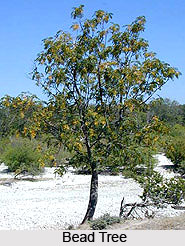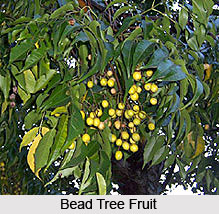 Having some similarity with the `Nim` in appearance, the `Bead Tree` is very much common in the Northern parts of India. The tree is known as `Melia Azedarach` in science. `Melia` is the Greek name of the `Ash` and `Azedarach` derived from the Persian word `Azad Darakht`. The name of its family is `Meliaceae`. This is named as `Deikna`, `Bakarja`, `Drek`, `Bakain` and `Malla Nim` in Hindi. In Bengali language, people usually call it as `Mahanim` or `Gora-nim`. It is known as `Mallay Vembu` and `Puvempu` in Tamil. The Telugu people named it as `Taraka Vepa`. `
Having some similarity with the `Nim` in appearance, the `Bead Tree` is very much common in the Northern parts of India. The tree is known as `Melia Azedarach` in science. `Melia` is the Greek name of the `Ash` and `Azedarach` derived from the Persian word `Azad Darakht`. The name of its family is `Meliaceae`. This is named as `Deikna`, `Bakarja`, `Drek`, `Bakain` and `Malla Nim` in Hindi. In Bengali language, people usually call it as `Mahanim` or `Gora-nim`. It is known as `Mallay Vembu` and `Puvempu` in Tamil. The Telugu people named it as `Taraka Vepa`. `
The size of the `Bead Tree` is medium and it grows very fast. The tree can achieve the height up to 12 m in only a few years. Despite of growing rapidly, its beauty does not last long. It dies off only at the age of about 20 years. The leaves of the `Bead Tree` are compound in formation and have some narrow and serrate-edged leaflets. These leaflets terminate into some small points. At the base, the leaves are sub-divided into several pinnas and bear five or seven leaflets. The bark of the tree is dark grey-brown in colour and cracks vertically by long furrows. The leaves fall down in the Winter and the tree becomes uncovered except for the masses of cherry-like fruits.
 The fruits of the `Bead Tree` are deliciously golden in colour when they become mature they attract the Bulbuls and other birds in large numbers. The spring flora appears by the month of March and the attractive sprays of little, lilac blooms follow them immediately. They grow very high up on the tree and they draw everyone`s attention to their presence by their wonderful fragrance. Though the fragrance is powerful, it is subtle. Whoever passes under the tree, looks up to see a huge amount of tiny drowsy blossoms loosely clustered on long-stemmed sprays. Each flower contains five or six narrow and violet or white petals. They reveal a deep purple tube when they open. When the monsoon is over, the fruits of the `Bead Tree`, which are not eaten by the birds, form and become furrowed. There are five seeds in each of the fruits and they have a natural perforation through the centre and when the pulp has been boiled off, they make ideal beads.
The fruits of the `Bead Tree` are deliciously golden in colour when they become mature they attract the Bulbuls and other birds in large numbers. The spring flora appears by the month of March and the attractive sprays of little, lilac blooms follow them immediately. They grow very high up on the tree and they draw everyone`s attention to their presence by their wonderful fragrance. Though the fragrance is powerful, it is subtle. Whoever passes under the tree, looks up to see a huge amount of tiny drowsy blossoms loosely clustered on long-stemmed sprays. Each flower contains five or six narrow and violet or white petals. They reveal a deep purple tube when they open. When the monsoon is over, the fruits of the `Bead Tree`, which are not eaten by the birds, form and become furrowed. There are five seeds in each of the fruits and they have a natural perforation through the centre and when the pulp has been boiled off, they make ideal beads.
Although, the `Bead Tree` is mainly an ornamental tree, it has quite a few other uses as well. The fruit of this tree posse narcotic qualities and they are poisonous in large quantities. However, a combination of the fruits and the leaves, a valuable poultice can be made and used in cases of headache or neuralgia. A highly inflammable and odour less gas can also be obtained from the berries of this tree and it can burn with a clear light. From the roots, people can acquire valuable oil. Though people do not often use the timber of the tree, its significantly marked and also very easy to work. It is employed mostly for making sheds, beams and small furniture. The origin of the `Bead Tree` is believed to be in North India and Burma. For a number of years, it has been held as sacred in Persia and Malaysia along with India.



















